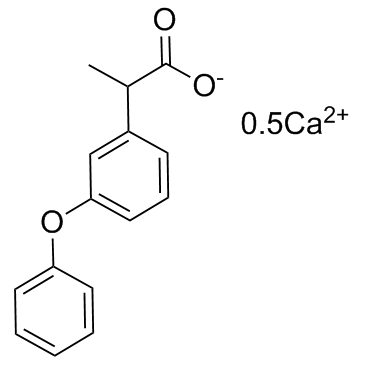34597-40-5
| Name | fenoprofen calcium (anhydrous) |
|---|---|
| Synonyms |
calciumfenoprofen
FENOPROFEN CALCIUM Fepron nalfon calcium methyl-3-phenoxybenzeneacetate fenoprofen-calcium dihydrate |
| Description | Fenoprofen Calcium is a nonsteroidal, anti-inflammatory antiarthritic agent.Target: Prostaglandin G/H synthase 1Fenoprofen is a non-steroidal anti-inflammatory, antipyretic, analgesic agent advocated for use in rheumatoid arthritis, degenerative joint disease, ankylosing spondylitis and gout. Fenoprofen has a serum half-life of about 150 to 180 minutes and is at least 99% bound to plasma proteins. It is extensively metabolised after oral administration, the main metabolites being fenoprofen glucuronide and 4-hydroxy-fenoprofen glucuronide [1]. Fenoprofen calcium is revealed for relief of mild to moderate pain in adults and for relief of the signs and symptoms of rheumatoid arthritis and osteoarthritis. In patients with osteoarthritis, the anti-inflammatory and analgesic effects of fenoprofen calcium have been demonstrated by decrease in tenderness as a response to pressure and reduction in night pain, stiffness, swelling, and overall disease activity. These effects have also been demonstrated by attenuation of pain with motion and at rest and increased range of motion in involved joints [2]. |
|---|---|
| Related Catalog | |
| Target |
COX |
| References |
| Density | 1.183g/cm3 |
|---|---|
| Boiling Point | 381.3ºC at 760mmHg |
| Molecular Formula | C15H14Ca0.5O3 |
| Molecular Weight | 262.31 |
| Flash Point | 141.7ºC |
| PSA | 71.06000 |
| LogP | 7.17980 |
| Storage condition | -20℃ |
CHEMICAL IDENTIFICATION
HEALTH HAZARD DATAACUTE TOXICITY DATA
|
| Hazard Codes | N |
|---|
